Advantages of laser quenching technology.
Laser quenching technology is a kind of surface heat treatment technology that uses a laser beam to heat the metal surface at a very fast rate to carry out impact quenching. It can also carry out surface layer fine grain strengthening solution. So what are the advantages of using laser quenching?
 Compared with other basic quenching methods, laser quenching technology has the following advantages:
Compared with other basic quenching methods, laser quenching technology has the following advantages:
1. The high-precision hard bottom layer of high quality can be obtained. The strength is 15%-20% higher than the basic quenching. After quenching, the wear resistance of pig iron can be increased by 3-4 times, and the quenched deep layer can be accurately manipulated.
2. Only use partial and thin surface heating at the key parts of the work, and the input product has less heat generation, and the effect of environmental protection and energy saving is very good.
3. The heat treatment process has small deformation and no mechanical equipment deformation. It is suitable for high-precision parts and can be used as the final solution process for raw materials and parts. It is because the laser power is high and the effective time with a certain point on the part is very short, so the thermal deformation zone and the overall change of the part are small. This advantage is especially prominent for long product workpieces and thick-walled product workpieces.
4. Because the light directly shines on the product workpiece, it belongs to non-touch heating and over-temperature protection quenching, so this technicality is a clean heat treatment process.
5. Good production and processing softness and wide range of use. It can use the flexible light guide system software to freely direct the laser to solve the position, and then it can easily solve the difficult-to-produce and process areas such as deep holes, internal threads, buried holes, and concave grooves and some areas with very small indoor space.
6. There is no significant mechanical equipment interaction force and special tool loss, low noise, low environmental pollution, pollution-free treatment methods, and good labor standards.
7. The processing technology cycle time is short, the production efficiency is high, and the production is low-cost. The entire processing technology can be operated by an electronic computer. The level of automation technology is high. It can be included in the automatic production line to facilitate mass production.
Choosing laser hardening technology can not only obtain high-precision hard underlayer, but also reduce environmental pollution to the natural environment. It is very critical. Many basic quenching technologies have relatively large environmental pollution to the natural environment, and the noise is also large, causing irreversible adverse effects.

1. The high-precision hard bottom layer of high quality can be obtained. The strength is 15%-20% higher than the basic quenching. After quenching, the wear resistance of pig iron can be increased by 3-4 times, and the quenched deep layer can be accurately manipulated.
2. Only use partial and thin surface heating at the key parts of the work, and the input product has less heat generation, and the effect of environmental protection and energy saving is very good.
3. The heat treatment process has small deformation and no mechanical equipment deformation. It is suitable for high-precision parts and can be used as the final solution process for raw materials and parts. It is because the laser power is high and the effective time with a certain point on the part is very short, so the thermal deformation zone and the overall change of the part are small. This advantage is especially prominent for long product workpieces and thick-walled product workpieces.

4. Because the light directly shines on the product workpiece, it belongs to non-touch heating and over-temperature protection quenching, so this technicality is a clean heat treatment process.
5. Good production and processing softness and wide range of use. It can use the flexible light guide system software to freely direct the laser to solve the position, and then it can easily solve the difficult-to-produce and process areas such as deep holes, internal threads, buried holes, and concave grooves and some areas with very small indoor space.
6. There is no significant mechanical equipment interaction force and special tool loss, low noise, low environmental pollution, pollution-free treatment methods, and good labor standards.
7. The processing technology cycle time is short, the production efficiency is high, and the production is low-cost. The entire processing technology can be operated by an electronic computer. The level of automation technology is high. It can be included in the automatic production line to facilitate mass production.

Choosing laser hardening technology can not only obtain high-precision hard underlayer, but also reduce environmental pollution to the natural environment. It is very critical. Many basic quenching technologies have relatively large environmental pollution to the natural environment, and the noise is also large, causing irreversible adverse effects.